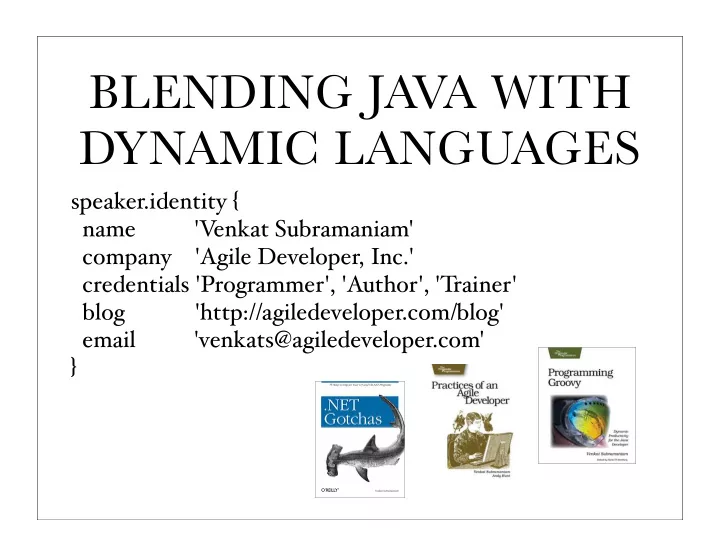

BLENDING JAVA WITH DYNAMIC LANGUAGES speaker.identity { name 'V enkat Subramaniam' company 'Agile Developer, Inc.' credentials 'Programmer', 'Author', 'T rainer' blog 'http://agiledeveloper.com/blog' email 'venkats@agiledeveloper.com' }
Abstract The last several years have brought us some exciting advances in the capability and strength of the Java platform. At the same time, developers are increasingly excited about the productivity gains promised by the use of dynamic languages. The good news is that it is possible to get the best of both worlds — to take advantage of dynamic languages and leverage your knowledge of and investments in the Java Platform at the same time! In this presentation we will take an in - depth look at mixing dynamic languages and Java in the same application. W e'll first look at it from the perspective of full interaction, and explore some idiomatic di ff erences in interaction. Then, from an application development perspective, we'll discuss how these can help in areas like Rules Engine, DSLs, and Meta Programming. 2
Java: The Language and the Platform Java started out as a powerful, yet simple language Through it we realized WORA — Write Once Run Anywhere ‘C’ like language with Automatic Garbage Collection Powerful set of API and libraries Strong community of passionate developers and innovators Now we realize, the real strength of Java is not in the language It’s in the platform 3
Dynamic Languages Dynamic Languages have been around for a long time Facilitate ease of metaprogramming, building DSLs, ... leading to higher productivity There is renewed interest in this area Why? Machines have gotten faster More Availability — community based development Awareness of test driven development Excitement from killer apps 4
Java Language s Java was once this single language on multiple platforms .NET was multiple languages on a single platform Now Java has become a true multiple languages on multiple platforms Groovy JavaScript JRuby Jython Java Bytecode Java Jaskell 5
Multi–Language Means What? Compiling from higher level languages to bytecode is not new But, multi – languag e means full interoperability with constructs created in di ff erent languages Can you inherit from a class created in another language? Can you associate or aggregate classes created in another language? Can you intermix them without major restrictions? 6
Why Mix Dynamic Languages? Dynamic Languages bring power of Metaprogramming and DSL to the table Can improve your productivity Y ou can allow your users to be more expressive Y ou can use it for Rule Specification in Rule Engines Y ou can let your program evolve Y ou can take dynamic decisions based on certain input or application state 7
API for Interoperability Languages to Java API/JDK Language specific facilities — di ff erent languages handle this di ff erently For example, here are options in Groovy Source: “Programming Groovy: Dynamic Productivity for the Java Developer” Java to other languages JSR – 223 is a standard API for language interoperability Useful to call from Java into other languages 8
JavaScript to Java Y ou can use Java API/JDK from within JavaScript 9
Idiomatic Difference One of the real fun in mixing languages is enjoying the idiomatic di ff erences It is about calling Java API but using syntactic sugar and facilities of dynamic languages Reduces code size, gives you productivity 10
Building Swing App using JavaScript 11
Building Swing App using Groovy 12
Calling JavaScript from Java Java allows you to call into scripts using JSR – 223 ScriptEngineManager allows you to query for and fetch ScriptEngines Once you obtain a ScriptEngine, use eval to execute any script 13
Calling JavaScript from Java... package com.agiledeveloper; import javax.script.*; public class Script { public static void main(String[] args) { try { ScriptEngineManager scriptManager = new ScriptEngineManager(); ScriptEngine engine = scriptManager.getEngineByName("groovy"); engine.eval("println 'Hello from Groovy'"); } catch(ScriptException ex) { System.out.println("Error in scripting: " + ex); } 14
Invocable Interface Allows you to invoke functions and methods package com.agiledeveloper; import javax.script.*; public class Script { public static void main(String[] args) { try { ScriptEngineManager scriptManager = new ScriptEngineManager(); ScriptEngine engine = scriptManager.getEngineByName("groovy"); engine.eval( "def count(val) { for (i in 1..val) { println i }; return 'Thank you for calling' }"); Invocable invocable = (Invocable) engine; Object result = invocable.invokeFunction("count", 5); System.out.println("Result from invocation is " + result); } 15 catch(Exception ex) ...
Compilable Interface If you’re going to make repeated calls to an interface you can ask it to be pre - compiled Provides more e ffi ciency 16
Groovy Simplifies this To call into Groovy from Java you don’t have to use JSR – 223 unless you want to use script as is ( without compilation ) Groovy provides join t compilation Y ou can compile Groovy code into Java bytecode and use it like any other Java code 17
Using Groovy with Java 18
A Small DSL Sample 19
A Small DSL Sample 20
References http://groovy.codehaus.org https://scripting.dev.java.net/ “Programming Groovy: Dynamic Productivity for the Java Developer,” by V enkat Subramaniam, Pragmatic Bookshelf, 2008. You can download examples and slides from http://www.agiledeveloper.com - download 21
Thank You! Please fill in your session evaluations You can download examples and slides from http://www.agiledeveloper.com - download 22
Recommend
More recommend